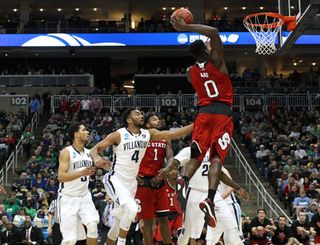Simply Mad: NCAAs Net More Viewer Growth

March Madness is as crazy as it’s ever been. Top seeds are falling left and right. Loads of games are coming down to the wire. The first full day of the 2015 NCAA men’s basketball tournament saw a record five games that were decided by just one point. The surprises came just a year after the national championship game featured a No. 7 seed vs. a No. 8, the highest in title-game history (the previous record was set only a few years earlier).
“You think you’ve seen it all and then this tournament comes along,” CBS Sports broadcaster Jim Nantz said earlier this month during CBS and Turner’s annual March Madness media day. “Every year, [tournament games] remind you that you could not have predicted what was going to happen.”
When former NBA commissioner David Stern instituted the age rule in 2005, stipulating a player had to be at least 19 years old and a year out of high school to be eligible for the draft, it created the so-called “one-and-done” system in college basketball. While many have argued it has hurt college hoops overall—the quality of play is down and the best players don’t stick around long enough to become stars like the Bobby Hurleys and Christian Laettners of past—it has evened the playing field for smaller schools, leading to more tournament upsets.
And it has also led to an unprecedented amount of ratings growth. The opening week of the 2015 tourney posted a 6.7 overnight household rating across CBS, TNT, TBS and truTV, the highest ever. The third-round game between Wisconsin and Oregon on March 22 drew a truTV-record 3.5 million viewers.
“The ratings have been remarkable,” said CBS Sports chairman Sean McManus. Last year’s tournament delivered the highest viewership through the first two weekends since 1993 (the 2014 Final Four aired on cable for the first time ever, which dented ratings somewhat).
“If you look at college basketball ratings, they’re up across the board,” said Turner Broadcasting president David Levy. “There is a lot of attention. I think there are a lot of good stories.”
A Dynamic Duo
Broadcasting & Cable Newsletter
The smarter way to stay on top of broadcasting and cable industry. Sign up below
While the increase in nail-biting finishes and a true “anybody can win” ideal has lifted the tournament, the increased exposure from CBS and Turner’s partnership, which began in 2011, has no doubt been among the biggest factors in March Madness’ rising ratings fortunes.
The partnership marked the first time that every tournament game was made available to viewers. Previously, when CBS carried the whole thing, early-round games were broadcast on a regional basis. “It’s rare in this industry for an arrangement and a deal to be as successful from all angles as this deal is,” said McManus, who added it’s been “remarkably successful” from a financial standpoint.
Added Levy of the current deal, which lasts through 2024: “This could go down in history as one of the best partnerships of two media companies.”
Aside from the increased TV coverage, both McManus and Levy credit the rapid expansion of digital and social media over the past few years as driving interest. Through the first week this month, NCAA March Madness Live has generated a record-setting 54 million live video streams, a 7% increase from last year.
“Building stars isn’t just the job now of the TV network,” said McManus, noting that game highlights can go viral in an instant. “The amount of attention they get on social media can create big stars overnight.”
TURNER SEEKS BETTER ‘TEAMCAST’ EDUCATION
For its Final Four debut last year, Turner wanted to include all of its networks in the action by airing team-specific “team-casts” alongside the main national telecasts. By all accounts, those were a major success. The Final Four averaged 14 million viewers for the two games across Turner’s three networks.
“It added interest. It gave fans another way to experience the tournament,” said CBS Sports chairman Sean McManus. “The response we got from fans is that they enjoyed it.”
However, there were some viewers who didn’t get the message that there would be team-specific telecasts, which led to confusion. TNT’s viewership was roughly three times larger than truTV’s for both games; TBS carried the main broadcast.
For the follow-up this year, Turner Broadcasting president David Levy focused on better marketing so viewers know which network is carrying which version. That includes having different graphic treatments for the team-casts, as well as additional social media promotion. For starters, the team-casts are under the banner “Team Stream Presented by Bleacher Report.”
